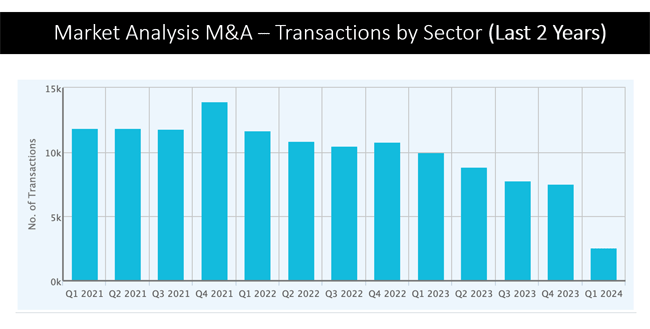
After a surge in healthy M&A transactions in 2021 following a decade of robust private equity dealmaking due to low interest rates, the transaction market had a marketable slowdown beginning in 2022 when the Federal Reserve began raising interest rates to combat inflation. This slowdown continued through the end of 2023.
There is no consensus, but rather mixed views on the current volume of M&A transactions. Transactions service professionals and investment bankers will tell you that they have been working with many potential sellers getting information ready to launch sales processes this Spring. However, this is the same outlook they have had each quarter since Fall 2022.
The reality is that healthy deal flow will remain subdued until more certainty is established on where middle-market valuations will land. Given the uncertainity in future Federal Reserve interest rate cuts, and the outcome of the November presidential election, my guess is that the slowdown in M&A will continue through the end of the year. At some point countervailing pressure on private equity funds from their limited partners to return capital will force private equity to transact, even at valuations they may prefer were higher.
Commercial bank lenders, for the most part, are increasing their desire for new loans. This came after many regional banks tightened their standards in response to the fallout from Silicon Valley and First Repbulic Banks' troubles. At the same time, private credit as an investment category for hedge funds has surged, bringing a boost in liquidity for transactions or refinances.
Although there is an increase in bankruptcy filings and much of the government support during the pandemic has worn off, most banks are reluctant to work out loans as private equity funds are injecting additonal slugs of equity to keep their companies out of default.
At Ravinia Capital we are seeing a large increase in inquiries relatwd to finding addtional debt for companies that have run out of easy-to-find liquidity. We are also involved in a number of discussions between lenders and debtors in forebearance where a sale is contemplated as the best next move forward.

"On the restructuring side, I think everybody's underestimated the strength of the economy. The interest rates went up so quickly. Because they went up so fast it's a much longer period for the interest rates to impact the market. I think it's going to be sort of a slow climb to increase restructuring activity."
~Mark Podgainy

"I don't think it's as much a result of underestimating the strength of the economy. I think it's more an issue of underestimating the amount of liquidity in the market and the impact this has on almost every other negative indicator out there. Cash and the need to put it to work to make money either hides or, at least temporarily, solves all sorts of problems that would otherwise need restructuring."
~Cynthia Romano

"I'm seeing capital start being redeployed again within private equity. There was a slow period beginning early 2022 through the end of the year 2023. So far in 2024 things are starting to pick back up again."
~Eric Brook

Source: https://www.spglobal.com/marketintelligence/en/
Nobody really knows whether we are about to be game back on for private equity, and back to normal, or if we're going to see a real push to workout.
There's a building amount of pressure coming from limited partners saying they need to get money back at a certain point.
"On the deal environment, the cost of debt is much higher than it used to be. I think it will stay high, and that's just going to depress deal making. With all that dry powder there will be a lot of pressure to put money out there."
~Mark Podgainy
We know interest rates are going to go down a little, but probably not a lot. There's still too much uncertainty for contracts.
What's going on in lending is also unclear.

"I haven't seen a single business that knows what their base year is anymore. Is it 2019, 2020, 2021, 2022 or 2023? Some businesses really don’t seem to have a clue what the baseline year is that they should use for budgetary purposes anymore."
~Robert Meyers

"Looking at the tightening of capital over the last 12 to 18 months we can see how it's changed from free, easy, cheap money, to now, more difficult and more costly money to get. I think that's changed the profile for a lot of companies that are on the edge. From Armory's perspective, we've definitely seen in the last six months, an uptick in distressed credits in both bank and private credit portfolios."
~Sandy Prabhakar
Banks certainly started to tighten after last Spring when Silicon Valley Bank and First Republic went down. They started to focus on getting deposits, and lending tightened.
At the same time, you had this strange phenomenon of private credit becoming the poster child for family hedge fund investments.
And as far as workout goes, banks were starting to get tighter and beginning to have difficult conversations, but overall, they haven't really been wanting to push out. We're starting to see it bank by bank; their own internal issues are forcing them to be tougher with clients.

"We still see a reticent for work-out solutions. It is the route of last resort that we see when other routes have failed."
~Jamie Simons

"I think the amazing part is that our economy is very resilient. I mean, during the pandemic, the Fed increased the interest rate by 11 times and so rapidly, and we thought, 'Oh my gosh, the world is going to fall apart. The restructuring work is going to go up pretty high.' But it didn't."
~Lilies Lanway